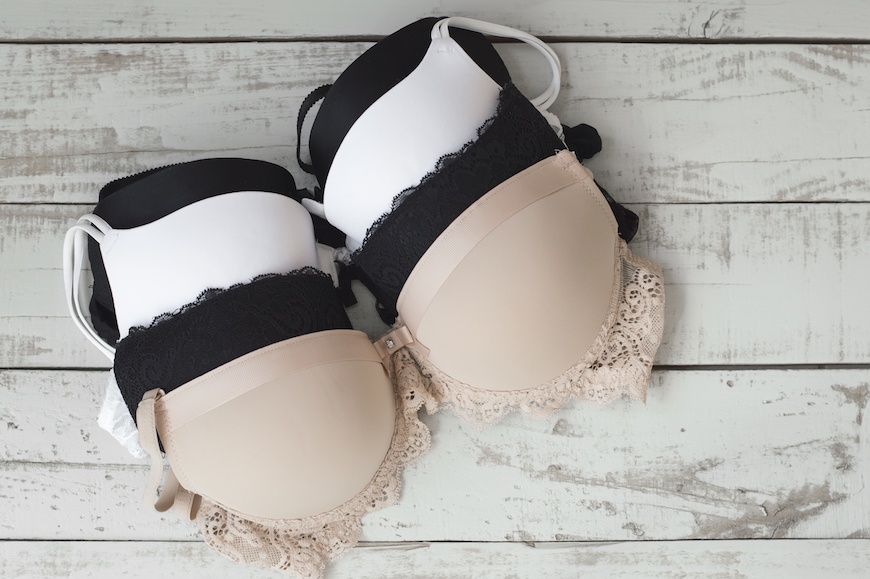As many of us learned, subtracting your band size from your bust size will give you your cup size. But actually, measurements alone aren't all that's required to determine your ideal bra fit. Breast shape, too, is a super important factor that most women were never taught to consider.
"Specific breast shapes lend themselves to specific cup shapes," explains Ra'el Cohen, chief creative officer of the inclusive bra company ThirdLove. "And there are so many cup shapes—there’s plunge, there’s demi, there’s [full] coverage. So while breast shape is only one question, it’s an important one because it really helps drive the person into the right style."
If you're wearing the wrong bra for your breast shape, you'll definitely know it. According to Cohen, some of the signs include gaping cups, slipping straps, underwire digging, and a gap between the center gore of the bra and your sternum.
Of course, everyone's breasts are different, and the best way to find your perfect bra is to get a professional fitting. (Or use an online, algorithm-driven fit finder quiz, like the ones from ThirdLove and True&Co.) There's also nothing that can replace the act of trying on lots of bra styles and experiencing which one feels best to you.
"How a bra feels on your body is what really matters when it comes to comfort and performance."
"How a bra feels on your body—specifically, how it feels in motion when running, doing yoga, even commuting to work—is what really matters when it comes to comfort and performance," says Alexandra Plante, director of innovation management at Whitespace, Lululemon's research and development lab. (The team behind the brand's game-changing, weightless-yet-supportive Enlite and Like Nothing bras.) "The experience is different for every woman based on their unique pattern of breast movement, personal feel preference, and of course, physical make-up or shape."

{{post.sponsorText}}
That said, there are a few overarching guidelines that you can keep in mind to help narrow down the overwhelming number of options when bra shopping—and when deciding which of your current bras to nix from your lingerie drawer. (Marie Kondo's "does it spark joy" method definitely applies to your boobs.)
Keep reading to find out how your breast shape affects the fit of your bra.

The link between breast shape and bra style
Unlike bra size, there's no industry-wide consensus on what the different breast shapes are. ThirdLove has identified nine distinct shapes, while True&Co. lists four in its fit quiz. And there are a lot of other factors that bra pros consider when recommending a style to someone, like specific fit concerns, daily activity profile, or the look they're going for. This means it's hard to make blanket statements about the breast shape-bra style relationship.
But when talking about shape in broad terms—and if you have specific imbalances you're looking to address—Cohen says some general recommendations do apply.
If your breasts are asymmetric: First of all, know you're in the majority—most women have one boob that's bigger than the other. But if this is the thing that stands out to you the most about your breasts, Cohen recommends a plunge-style bra with removable inserts. "If you had a cup that covered your entire breast, the level of asymmetry would be very obvious because one cup would be caving in and the other one would be sticking out," she says. "A plunge bra is a smaller cup and it has more of an angled neckline. Just remove the pad on the larger side and keep it in on the side that’s smaller, and it will help even out your silhouette and cleavage."
If your breasts are bottom-heavy: Ta-tas that are flatter on top and fuller on the bottom need extra support, says Cohen—skimpy bralettes probably won't be comfortable, even if your breasts are on the smaller side. "You want to make sure you have a full, supportive wire," she advises. If you have larger breasts, you may also want to consider a full-coverage cup to help dial up the support even further.
If your breasts are wide-set: Can you fit more than three fingers in between your boobs? That means you likely fall into this category. "Often times, if somebody identifies themselves as being wide-set, it probably means they want a bra that will pull their breasts together a little bit more," she says. "You would look for a plunge style with an outward half wire. A full wire would dig into you [in the sternum area], because your tissue is further out."
If your breasts are athletic: "Women with a more athletic shape have less breast tissue and a wider rib cage," explains Cohen. "A T-shirt bra with a flexible wire and a more shallow demi cup is [ideal], depending on other factors." But this is one case where size really does matter, she adds. "Somebody can be athletic and a 38F, in which case they'd need more coverage."
Oh, and one other thing to keep in mind: Just as your bra size changes throughout your lifetime, so does your breast shape. "Having kids, gaining or losing weight, aging—all of these things can affect your breast shape," says Cohen. "It’s always great to reevaluate whenever you go through these life changes." In fact, you may as well reassess your shape whenever you buy a new bra—after all, when it comes to your melons, there's no such thing as being overly familiar.
It's a really good time to be a bra consumer. This option can help detect breast cancer, while another new brand shifts in size as your body does.
Loading More Posts...